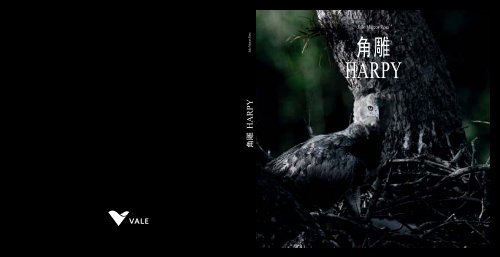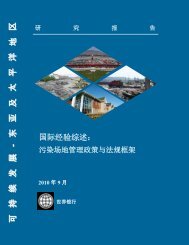角雕
角雕
角雕
Create successful ePaper yourself
Turn your PDF publications into a flip-book with our unique Google optimized e-Paper software.
<strong>角雕</strong><br />
<strong>角雕</strong>
HARPY<br />
NITR<br />
巴西 2010
<strong>角雕</strong>原产于墨西哥南部至阿根廷北部的热带雨林 。如今这<br />
种鸟类依然栖息在卡拉加斯国家森林的山谷中,与命运抗衡<br />
7
HARPY<br />
17
Message from the CEO<br />
Commitment to sustainability is a key focus of Vale. By integrating our operational activities with<br />
conservation and restoration of the ecosystems of the areas where we are settled into, we became<br />
one of the Brazilian companies which contribute the most to the preservation of Brazil’s biodiversity.<br />
Therefore, we are very proud of being part of such an important and noble project: the preservation of<br />
the harpy eagle, one of the largest and most beautiful birds of prey in the world.<br />
In partnership with Chico Mendes Institute for Biodiversity Conservation (ICMBio) and National Institute<br />
for Amazonian Research (INPA) , during eight months Vale monitored two harpy nests found in the<br />
Carajás National Forest . As a result, this book is coming out with pictures not published before and with<br />
information on a species which is very important to the Brazilian biodiversity.<br />
I hope the images which beautify the pages in this book help stimulate environmental awareness. I also<br />
expect it to be evidence of our ability and obligation to preserve and protect our environment.<br />
Roger Agnelli<br />
President & CEO<br />
19
22<br />
R788h Rosa, João Marcos<br />
Harpia / João Marcos Rosa (fotos) . Textos de Frederico Drumond,<br />
Tânia Sanaiotti, Roberto Azeredo. Belo Horizonte: Nitro, 2010.<br />
144 p., principalmente fotografias (coloridas).<br />
Texto em português, com tradução paralela em inglês.<br />
ISBN: 978-85-62658-01-3<br />
1. Harpia – Fauna silvestre. 2. Biodiversidade – Pesquisa –<br />
Conservação. I. Título. II. Drumond, Frederico. III. Sanaiotti,<br />
Tânia. IV. Azeredo, Roberto.<br />
CDD: 598.2<br />
CDU: 598.2<br />
Informação bibliográfica deste livro, conforme a NBR 6023:2002 da<br />
Associação Brasileira de Normas Técnicas (ABNT):<br />
ROSA, João Marcos. Harpia. Belo Horizonte: Nitro, 2010. 144 p. ISBN<br />
978-85-62658-01-3.
24<br />
58<br />
90<br />
ABOUT THe AUTHOR<br />
138<br />
ACkNOwleDgeMeNTS<br />
144<br />
23
24<br />
卡拉加斯国家森林中的<strong>角雕</strong><br />
Frederico Drumond Martins<br />
Chico Mendes生物多样性保护研究所环境分析师<br />
卡拉加斯国家森林负责人
The Harpy Eagle in Carajás National Forest<br />
Frederico Drumond Martins<br />
Environmental Analyst for ICMBio - (Chico Mendes Institute for Biodiversity Conversation)<br />
Head of the Carajás National Forest<br />
It was with great honor that I accepted the invitation to participate in this book of wonderful pictures, which<br />
crowns the work on the Harpy Eagle, one of the species I admire the most. First of all, I would like to extend<br />
an invitation to the reader: Come visit the Carajás National Forest. It is a place of indescribable beauty,<br />
immense diversity of plants and animals, and it is the landscape in most of the pictures in this book.<br />
The Carajás National Forest is an area of 400 thousand hectares ( 988.4 acres ) of protected land<br />
and significant sample of Amazonian biodiversity. The forest borders four other preserved areas as well<br />
as an indigenous reserve. This mosaic of protected areas, within a one-million-hectare area of continuous<br />
rainforest, has become the biggest remaining preserved ecosystem in southern and southeastern Pará.<br />
For the great anthropogenic pressure in this part of Brazil, Carajás National Forest became shelter for<br />
several species of the rare and endangered fauna and flora.<br />
The Canopy Queen<br />
Among the more than 600 bird species already catalogued in Carajás, one can find the largest Brazilian<br />
eagle, the Harpy Eagle. The first accounts of seeing this species have been reported in the region since<br />
the first time there was a published list of birds. Two nests have recently been discovered – both with<br />
actively reproductive couples – indicating environmental protection. A preserved area is the primary<br />
requirement for the couple’s choice of a growing tree that will provide them with a good view of the<br />
whole forest. A good view will allow them to collect sticks for nest maintenance and mainly hunt in a defined<br />
territory, ensuring the survival of future generations.<br />
Studies of bioindicators, such as the Harpy Eagle, are fundamental tools for the management of a<br />
conservation unit. They help interpret the environment and direct priority actions for achieving the ultimate<br />
goal of any protected area: The conservation of their ecosystems. The finding and monitoring of these two<br />
nests raise some questions, such as the need to restrict the use of nesting areas, ranging from protection<br />
of the trees used for its construction to protection of the territory of the Harpy couples.<br />
25
Awareness and union<br />
The beauty and grandeur of the Harpy Eagle promotes the interest in knowing and preserving our<br />
biodiversity, thus making environmental education such an important tool to raise awareness of the<br />
surrounding forests dwellers. The accounts and information acquired from monitoring the nests have<br />
been shown in science fairs, academic lectures, and social works. These actions have raised awareness<br />
among the forest’s neighbors of the importance of environmental protection.<br />
The discovery of the first nest incited a strong partnership for the protection of these species.<br />
The Chico Mendes Institute for Biodiversity Conservation (ICMBio) , paved the way to the Harpy Eagle<br />
Protection Program by supporting the Carajás National Forest in becoming an important area in the<br />
studies of the Harpy. The mining company Vale, an environmentally responsible company, has embraced<br />
the program providing necessary resources for sharing research and visual records. The National<br />
Institute for Amazonian Research (INPA), a specialized institution in the region, coordinates the activities<br />
in Carajás, and with all its experience in this forest, is planting a seed that is already beginning to bear<br />
fruits.<br />
The second nest found further strengthened this partnership, encouraging each institution to reflect<br />
on their role in controlling human predatory activities, particularly deforestation and replacement of<br />
forests in landscapes that do not allow for the preservation of biodiversity. With the group work among<br />
the institutions involved, this project will open up, with realism and maturity, new ways toward the<br />
protection of the Harpy Eagle in Brazil.<br />
27
Despite its large size that can reach 2.2 m ( 7.2 feet ) the harpy<br />
shows grace and skill when landing in the nest. Carajás, Pará<br />
29
30<br />
In the small clearing amid the forest, the housing along the Águas<br />
Claras River serves as one of the main bases for the researchers.<br />
They fully utilize the structure, which was initially built to house<br />
mineral exploration teams. Carajás, Pará
As seen from a helicopter, the Carajás National Forest seems to<br />
be an impenetrable surface<br />
37
Detail of a nestling’s feather collected from under the tree where<br />
the Águas Claras nest is located. Carajás, Pará<br />
39
The prey taken by the male will feed the female and the<br />
one-month-old nestling. Until the nestling reaches two<br />
months of age, the mother remains close to the nest and<br />
only the male hunts. Carajás, Pará<br />
41
42<br />
The female harpy weighs 10 kg (22 lbs.) and is about one-third<br />
larger than the male. weighing no more than 6 kg ( 13.2 lbs. ),<br />
the adult male is more agile and a better hunter
44<br />
Students at the Jorge Amado School in the vicinity of the Carajás<br />
National Forest participate in a class about the harpy eagle.<br />
Researchers use environmental education as a tool to have<br />
the community sympathize with the project and become partners<br />
in it. Carajás, Pará
After being caught in a farmer’s house by the ICMBio team, this<br />
animal is going through a rehabilitation process at the Carajás<br />
Zoobotanica Foundation. It is being prepared to carry a radio<br />
transmitter once it returns to the wild<br />
45
The expansion of farming is one of the biggest threats to the<br />
species. In the picture, one can see a pasture land moving towards<br />
the Parauapebas River, a natural border of the Carajás National<br />
Forest<br />
47
52<br />
In this rarely documented moment, the female returns to its nest<br />
carrying a primate in its claws. when the nestling is two months<br />
old, it is more frequently fed; therefore, it quickly gains weight.<br />
Carajás, Pará
The Majestic Harpy in Brazil<br />
Tânia M. Sanaiotti<br />
Researcher, National Institute of Amazonian Research(INPA)<br />
Coordinator of the Harpy Conservation Program<br />
The study about the harpy is more than anything an exciting lesson of patience. Owner of discrete<br />
habits and often silent, this eagle is considered the strongest in the world because its claws can carry<br />
prey which weighs as much as it does. Males weigh about 6kg (13.2 lbs.) and female about 10kg (22<br />
lbs.). Unlike other birds, the harpy vocalizes only during mating periods and when feeding its nestlings.<br />
Therefore, it is not so simple of a task to dentify its presence in the forest; thus almost always requiring<br />
from the researcher few techniques used by its own object of study. Breath to climb trees over 40 meters<br />
tall (131.2 feet ), physical strength ,and a refined sense of observation are some of the requirements to<br />
spy on the harpy while it is majestically housed in the canopy, as well as to try and decipher some of<br />
the mysteries of the bird whose wingspan exceeds two meters (6.5 feet).<br />
It is from these tall trees with privileged views of the forest that the far-sighted and highly developed<br />
hearing harpy, after detecting its prey, takes flight in high speed to attack with perspicacity. The ability<br />
to rotate its head 180 degrees also contributes to the success of the hunt. Its target is primarily arboreal<br />
herbivorous animals, such as sloths and monkeys. Other vertebrates which also inhabit the canopy,<br />
such as porcupines, toucans and macaws, complement this predator’s diet. In Brazil, the harpy lives in<br />
the Amazon and Atlantic rainforest and in the riparian forests of the Cerrado. In the riparian forests, as<br />
well as in Pantanal, it flies over open green areas between mountains and rivers, feeding on armadillo,<br />
deer, and coati.<br />
59
A Conservation Program<br />
The first description of the harpy in the books was made by European naturalists in the eighteenth<br />
century, when the species lived in most of the great forests from southern Mexico to northern Argentina.<br />
Nearly three centuries of overexploitation of natural resources are between these publications and the<br />
first Brazilian research and conservation project about the species. The discovery of a nest near Manaus<br />
in 1999 prompted researchers from the National Institute of Amazonian Research (INPA) to turn their<br />
attention to the species. After that, new nests were recorded, mapped and monitored by biologists and<br />
climbers who form a multidisciplinary team in the “Programa de Conservação do Gavião Real”(Harpy<br />
Eagle Conservation Program).<br />
The project was named after one of the many names by which the eagle is known in the country.<br />
The nickname “gavião-real” (royal eagle) is due to the impressive size and the feather crown on its<br />
head. The scientific name Harpy harpyja refers to a Greek mythology being which is half eagle and<br />
half woman. However, among the people of the forest there are many nicknames:“Uiraçu-falso” (fake<br />
uiraçu), “gavião-preguiça” (sloth-hawk), and “ gavião-neném” (baby-hawk).<br />
Over a decade, the work of the program was made possible only with the collaboration of other<br />
good local observers. For the research of nests, INPA relies on the cooperation of various sources,<br />
mostly proprietors or neighbors of lands where harpies were seen, and the precious help of the staff of<br />
protected areas. Because of that, the strategy used in the Harpy Eagle Conservation Program is linked<br />
mainly to the involvement of traditional communities of the surroundings of the protected areas, and to<br />
the consolidation of partnerships with federal, state, and private institutions. These strategies facilitate<br />
the disclosure of the importance of environmental preservation and of the successful results already<br />
achieved.<br />
This support network enhances the activities of the biologists of the project in different fronts. It<br />
identifies the processes and variables that influence the distribution and abundance of the harpy in<br />
the Brazilian forests, and studies the degree of loyalty from species to nesting areas. Quantitative and<br />
qualitative analyses of collected preys are run in order to identify the animal’s diet.<br />
With the use of technology, the monitoring of young eagles by telemetry is another field of research.<br />
The tool helps determine the population dispersion, while analysis of population density contributes to a<br />
more accurate definition of the status of the species’ preservation. A group of researchers in a laboratory<br />
run genetic studies and collaborates with captive breeding programs of the species. Rehabilitation and<br />
reintroduction might also contribute, in some cases, to the expansion of protected areas, and to add<br />
value to existing forests in the surrounding areas.<br />
61
Threat<br />
The presence of this bird of prey collaborates with the natural equilibrium in the ecosystems where<br />
it lives. The harpy can control the number of individuals of prey species, hence the importance of its<br />
preservation, as it is considered an “umbrella” in other species protection. Located at the top of the food<br />
chain, the harpy has no predators other than men, which, historically, have been devastating their habitat.<br />
The indiscriminate hunting and the use of harpy in traditional rites of some societies also contributed<br />
to its endangerment according to the list of the International Union for Conservation of Nature (IUCN). It<br />
is important to note that the conservation status of the harpy eagle in Brazil is controversial. The large<br />
geographical extent of our country provides contrasts. For instance, the existence of widely preserved<br />
forest areas in regions such as the Legal Amazon, where the population of the eagle still seems to be<br />
preserved, contrasts with the great anthropogenic pressure in areas such as the states of Espírito Santo,<br />
São Paulo and Rio Grande do Sul. These states, which are part of the Atlantic rainforest biome, officially<br />
list the harpy as endangered.<br />
There is still time to reverse the situation. For this, political, social, and economic measures based<br />
on data collected by researchers who seek answers to environmental conservation are imperative. The<br />
charisma of species such as the harpy eagle, considered by some indigenous people as the queen of<br />
the forest, can form a large network for the maintenance of biodiversity and of men, who are, like any<br />
other species, so dependent on this planet.<br />
63
64<br />
In flooded forests, the “igarapés” form the routes that lead to<br />
the nests . In this environment, canoes are the only possible<br />
means of transportation. Manacapuru, Amazonas
66<br />
Biologist Benjamim da Luz analyzes the first harpy nest found<br />
in Bahia. Private Nature Reserve estação Veracel, Porto Seguro
Part of forest land burned in Parintins, Amazonas. Collecting<br />
data on the harpy’s habitat before the deforestation is one of the<br />
major challenges of researchers<br />
69
70<br />
Under the gaze of an interested riverside child, Tania Sanaiotti<br />
observes a nest in Parintins, Amazonas
74<br />
Jaílson Santos from ICMBio and José eduardo Mantovani from<br />
INPe track two harpies that carry radio transmitters in the Pau<br />
Brazil National Park. eunápolis, Bahia
Researcher Alexander Blanco manipulating a nestling which,<br />
while on the ground, will be measured, have samples collected,<br />
and have a radio transmitter implanted . Imataca Forest Reserve,<br />
Venezuela<br />
75
Although still having juvenile plumage, this nestling already<br />
shows beneath its wings the standard gray and white colors<br />
that identify this species. Parintins, Amazonas<br />
81
Observed by a nestling, the researcher looks for anchorage in<br />
order to safely reach the nest. Parintins, Amazonas<br />
87
In a school by Cururu lake, biologist Tania Sanaiotti holds one<br />
more lecture on the harpy eagle. Involving locals in the conservation<br />
of the species is crucial to the project’s success. Manacapuru, Amazonas<br />
89
Men and Harpies<br />
Roberto Azeredo<br />
Researcher and President of CRAX Brazil-Society for Research on Reputation and Management of Wildlife<br />
It has been thirty years since I first saw a harpy eagle in nature. I was wandering around Vila Rica,<br />
northeast of Mato Grosso, in one of the most preserved places that I have ever been. Landing on a<br />
branch on the dry bank of the river, the harpy eagle suspiciously gazed at me. Petrified and astonished,<br />
I watched the grandeur and beauty of this bird. This image is still clearly engraved in my memory.<br />
Years later, we have already been working with extremely positive results in breeding and reintroducing<br />
into nature the red-billed curassow (Crax blumenbachii), the black-fronted piping-guan (Pipile jacutinga),<br />
and the solitary tinamou (Tinamus solitarius) in remnant areas of the Atlantic rainforest. Due to the<br />
success achieved by working with these endangered species, we set off for a new challenge: Develop<br />
a similar program for the Harpya harpyja.<br />
The first formation of a harpy couple in CRAX happened in 1998. To our delight, in April 1999, our<br />
research succeeded in getting a nestling to be hatched and raised in captivity by its parents. The work<br />
with reproduction succeeded and eleven more animals of this species were conceived in our research<br />
center in Contagem, Minas Gerais. These numbers encouraged us to move to the following phase. In<br />
mid-2006, in order to come up with an interdisciplinary project aiming at the reintroduction of harpies into<br />
nature, we gathered a group of leading researchers involved with the species. The plan was approved<br />
by IBAMA, but we didn’t get financial aid for its implementation.<br />
Nowadays, I am sure Brazil is ready to channel empirical studies to a practical consequence: The<br />
reintroduction of this animal into the wild. We can achieve the same success that the Spaniards achieved<br />
with their Spanish imperial eagle (Aquila adalberti), and the United States with the iconic bald eagle<br />
(Haliaeetus leucocephalus). There is no point in continuing the research if the ultimate goal is not the<br />
closing of a cycle: The return of the species to the forests. If we follow the pioneering example of working<br />
with the red-billed curassow, which starting from eight animals three hundred were reintroduced into<br />
nature, in a few decades we will be able to see the harpy flying in the remnants of Atlantic rainforest.<br />
91
Recently, a great achievement in Brazil broke several taboos and reheated the debate on the subject.<br />
For the first time an eagle after being in captivity for more than ten years was released and reintroduced<br />
to its habitat. It was a female, captured nearly 13 years ago on a farm, in Bahia. Researches, rehabilitation,<br />
and follow-up assessments considered the animal capable of returning to nature. The eagle then lifted its<br />
first flight in August this year, on the private nature reserve (PRNP) “Estação Veracel” ,in Porto Seguro.<br />
Constant monitoring of this animal free in the forest gives us important insights into believing that its<br />
adaption and equilibrium with nature is possible, despite the long time away from its environment.<br />
I dream of the day when people will know more about the harpy and will get involved in preservation<br />
projects, not only for this eagle but for the entire ecosystem involved. Disclosing the beauty and importance<br />
of the harpy as a flagship species for environmental protection is crucial to ecological training, as well as<br />
to encouraging the search for new projects. I believe this bird of prey, because of its mythical legends<br />
in Central and South America, can become an icon of environmental programs, as it did in Ecuador and<br />
Panama. In both countries, the harpy is representative of biological diversity.<br />
Keeping an eye on the future, the work developed in the Carajás National Forest is an example of local<br />
community participation in the fight for preservation. This kind of action should be spread throughout<br />
the country, and policies must encourage and support the development of projects about endangered<br />
species. Initiatives of this magnitude do not have immediate results, but in the long run can contribute to<br />
the improvement of the quality of life on the planet. I believe this beautiful publication is one more step<br />
on this long journey.<br />
93
Falconry techniques are used to help manipulate animals in captivity,<br />
preparing them for artificial insemination procedures. CRAX’s<br />
goal is to reintroduce into nature the nestlings that are born.<br />
Contagem, Minas gerais<br />
95
98<br />
A never- seen - before image: the hatching of a harpy’s egg.<br />
CRAX, Contagem, Minas Gerais
100
101
102<br />
In order to relate differences and consistencies between the harpy<br />
populations in Amazon and in Atlantic rainforest, feather<br />
fragments are collected for genetic studies of the species. Museum<br />
of Natural Science, PUC Minas
103
104
The black squirrel monkey (Saimiri vanzolinii) and other<br />
arboreal mammals are also part of the harpy’s diet<br />
105
106
Bones of eaten preys are collected by researchers in the nests<br />
and surrounding the respective trees. The analysis of these samples<br />
is essential to identifying the harpy’s prey<br />
107
108
Still fragile and clumsy , the nestling shows its claws on its first<br />
day of life. CRAX, Contagem, Minas Gerais<br />
109
110
During the warmest moments of the day, the mother’s shadow<br />
is the only protection for the nestling. Carajás, Pará<br />
111
112<br />
The name Harpia harpyja refers to greek mythology. It<br />
designates a hybrid being: half woman, half eagle
113
114<br />
The various roads in the Carajás National Forest make the<br />
work more dynamic and productive, as opposed to what<br />
occurs in other research areas, where access to nests is only<br />
through trails or rivers
115
116<br />
with its hallux up to 7cm long (2.75 in.) , a harpy’s claw is<br />
bigger than that of a brown bear
This harpy , equipped with a transmitter, was reintroduced into<br />
nature after 13 years in captivity. eunápolis, Bahia<br />
117
118
119
120
In order to increase nest observation time, the researchers’<br />
routine begins early<br />
121
122<br />
Benefitting from its wide wingspan, the harpy protrudes from<br />
the top of a chestnut tree. Carajás, Pará
123
124
125
126
127
128
129
130
131
132
The nestling’s first flight is normally within the branches<br />
of the tree where its nest is located . Because they are lighter<br />
than the females, males start these attempts when they are 5<br />
months old, while females may take up to 7 months to leave<br />
the nest. Carajás, Pará<br />
133
134
135
136<br />
Learning to fly and hunt , the nestling exercises its claws<br />
carrying a clump of roots. Carajás, Pará
137
138
About the author<br />
In the February 2006, an essay on harpies published in National Geographic Brazil was the first<br />
publication about João Marcos Rosa’s valuable work on the largest bird of prey in the Americas. It now<br />
culminates in the publication of this groundbreaking book.<br />
The idea of documenting this extraordinary species, the Harpy harpyja, arose in 2004. When João<br />
was introduced to the harpy in Parintins (AM), the sound of chainsaws next to the eagle’s nest warned<br />
him: It was necessary to show that the bird, despite being apparently imposing, was valuable and<br />
exposed to the folly of its habitat deforestation.<br />
Early in his career, João served as assistant to Araquém Alcântara who has been for over 30 years<br />
an important figure in environmental photography in Brazil. João inherited from his knowledge in using<br />
natural light and certain poetic vein to compose pictures of wildlife. Nevertheless, in an underlying<br />
aspect, João went further: the diversity of animals’ behavior. This book attests to that.<br />
He traveled dozens of times to the Pará, Mato Grosso do Sul, Amazonas, Bahia and Venezuela - he<br />
spent thousands of hours either on a plane, boat, canoe, ferry, helicopter, walking, or in a car. As done<br />
for the National Geographic magazine, which preaches the total immersion of the photographer into the<br />
environment of the species - whether it’s a polar bear or an ant - João had to literally get off the ground.<br />
He learned to climb trees to reach nests. He faced an old fear of heights (he says it still exists) to see<br />
the harpy’s life from its angle: the top.<br />
In the Amazon and in the Atlantic rainforest, he captured unseen images of the harpies hunting,<br />
showing their wingspan in full flights, protecting their nests, and feeding their nestlings. During his<br />
journey to Parintins, he had a remarkable moment when, amazed at the beauty of the enormous animal<br />
crossing the sky, he couldn’t trigger his camera. With trembling hands, a few seconds later he could<br />
finally capture the image of the bird landing on the tree with a prey in its claws. Seeking a balance<br />
between wildlife records and science, his work progressed toward recording the daily life of researchers<br />
in the field, in laboratories, and the efforts of captive breeding.<br />
The most special moments of his long journey have certainly happened in Carajás National Forest<br />
(PA) in 2009. From a 35m tall platform ( 14.8 feet) built on a chestnut tree, he could follow the copulation<br />
of a couple of harpies, the hatching of an egg, and the birth and development of the nestling. The history<br />
of this bird of Carajás is symbolic. Fortunately, as João Marcos Rosa’s pictures show us, life is renewed<br />
for the harpies in Brazil. This book is an encouragement for the preservation of the species.<br />
Ronaldo Ribeiro<br />
Senior Editor - National Geographic Brazil<br />
139
140
From a 131.2 feet high platform, photographer João Marcos<br />
Rosa records life in a nest. Carajás, Pará. (Photo: Marcus Canuto /<br />
SOS Falconiformes)<br />
141
142
143
144<br />
Acknowledgements<br />
巴伊亚(Bahia):Carlos André、Catão、Davi、Delgado、<br />
Denise、 Eduarda、Fernando Brutto、Gil、Jaílson、<br />
Lígia、Manoel、 Olândia、Rafael、Raquel、Sandro、<br />
Sara、Sérgio e Valdemir<br />
波尼多(Bonito):Adílio、 Alexandre、Faete e Nelson<br />
Chemin<br />
卡拉加斯(Carajás): Aline、Borges、Deuzimar、Duart、<br />
Edna、Ezaú、Fernanda、Figueiredo、Fred Drumond、<br />
Jardel、 Joãozinho、Josiel、Mesquita、Nívea、Nonato、<br />
Roberto、Renilson e Seu Manoel<br />
马纳卡普鲁(Manacapuru):Dunga、Peruano e comunidades<br />
do Lago do Cururu<br />
马瑙斯(Manaus):Adnes、Áureo、Benjamin、Capitão<br />
Ferreira、Dica、Helena、Ivan、Júlio、Marcelo、Olivier<br />
e Tânia<br />
米纳斯吉纳斯( Minas Gerais): Bete 、Bruno、Cadu、<br />
Canuto、Carol、Daniel、Eduardo、Geer<br />
Scheres、Gislene、Gustavo、James Simpson、Leo、<br />
Marcus、Nidin、Roberto Azeredo e Jorge。<br />
巴西国家地理杂志( National Geographic Brasil):Cris<br />
Catussatto、Cris Veit、Karen Pegorari、Matthew Shirts、<br />
Ronaldo Ribeiro e Roberto Sakai<br />
帕林廷斯(Parintins):Domingos、Seu Paraná e comunidades<br />
da Vila Amazônia<br />
淡水河谷(Vale):André、Alexandre Castilho、Eduardo、<br />
Fernanda Magalhães、Jeovanis、João Carlos Magalhães、<br />
José Carlos Martins、Karla Melo、Luiz Batista、Paulo<br />
Bueno、Regina e Sérgio<br />
委内瑞拉(Venezuela):Blás e família、Fernando Juaregui、<br />
Pilar Alexander Blanco e Roger<br />
协助单位 SUPPORT<br />
CRAX Brasil - Sociedade de Pesquisa do Manejo e da<br />
Reprodução da Fauna Silvestre<br />
FUNPZA - Fundación Nacional de Parques y Acuarios de<br />
Venezuela<br />
ICMBio - Instituto Chico Mendes de Conservação da<br />
Biodiversidade<br />
INPA - Instituto Nacional de Pesquisas da Amazônia<br />
National Geographic Brasil<br />
Revista Globo Rural<br />
SOS Falconiformes<br />
Veracel






